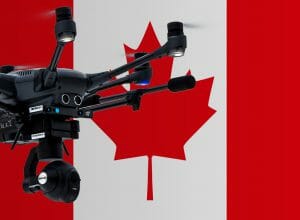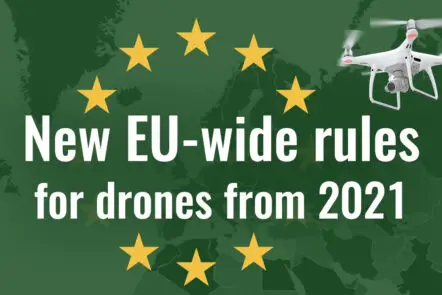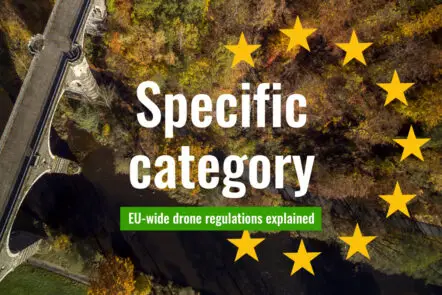Drone Laws in Canada
Last update on 08.03.2022 | 4 Kommentare

This article provides an overview of the current rules in Canada for using drones.
Since June 2019, stricter rules have been in force. Some people have already given up and decided they will not take their drone with them. There is a persistent rumor that foreign drone pilots are not allowed to fly in Canada. But do not worry, some of our readers have successfully applied for permits.
Transport Canada is responsible for the most important drone rules. It has established the “Canadian Aviation Regulations” (CARs), which deal with drones in Part IX – “Remotely Piloted Aircraft Systems”. It’s best to read these completely before flying your drone for the first time.
Overview: Drone rules in Canada
Drone labels can be ordered here
Requirements for drone pilots in Canada
Regardless of the categories we will discuss later, all drone pilots must adhere to the general rules.
That is, do not put people, animals or other aircraft in danger, keep the drone within visual line of sight, respect the privacy of other people and comply with any other applicable laws, for example, do not enter private land without permission. In addition, you must not operate a drone or be part of the drone team if you are under the influence of alcohol or drugs. For alcohol, there must be at least 12 hours between drinking and flying.
Private pilots do not need liability insurance. Nevertheless, an appropriate policy is recommended. Further information can be found in our article about drone insurance.
Before each flight, drone pilots must conduct a survey of the area, provide appropriate emergency and security measures, and also consult:
- Notice to Airmen – NOTAMs*: NAV CANADA NOTAMs
- the Canada Flight Supplement
- the Designated Airspace Handbook
- appropriate aeronautical charts (any aeronautical information is sufficient, this may include aeronautical charts listed on the NAV CANADA website.)
*NOTAMs inform the pilots about events and obstacles that might affect them. All NOTAMs contain the time and location of the event. Simply enter the ID of a nearby airfield into the NAV CANADA NOTAMs site to find NOTAMs near you.

Safety distances and flight bans
In Canada, you are only allowed to fly your drone below 122 meters (400 feet). It must remain within visual line of sight, so it must not be obscured by clouds, fog, trees, buildings or other obstacles.
Keep the safety distances of 5.6 kilometers to airports and 1.9 kilometers to heliports, also keep distance to airfields.
A first overview of critical zones can be found in this map.
Do not fly near announced public events such as concerts, parades, markets or sporting events. If you want to do this for some reason, you need a special permit.
Also, do not approach emergency operations and natural disasters such as forest fires so as not to interfere with the work of rescue crews.
For flights in the border area: Stay in the Canadian airspace.
Controlled airspace
Operations in controlled airspace require approval by air traffic control. Apply for an RPAS permit for the airspace controlled by NAV CANADA.
You will need to know what the region where you want to fly is called. You can find the names on this map.
To fill out the online form, you also need information about your planned flight, for example coordinates, radius, type of drone etc.
If you have your permit for flying in controlled airspace, you must carry it with you. In addition, you must have a way to communicate constantly with air traffic control during the flight.
National parks
Drone pilots are not allowed to take off or land within a national park.
A park ranger may in some cases allow the use of drones. If you want to fly a drone in a national park, learn about the use of drones in the parks and contact Parks Canada.
Apply for permits
Canada has introduced several categories of drone pilots that you should first familiarize yourself with. This will help you to find out which rules apply to you.
Distinction by weight
If your drone weighs less than 250 grams, you do not need to worry because it does not need to be registered or require a pilot’s license. However, you must follow the general safety rules.
If your drone weighs more than 25 kg or you want to fly over public events, you need a special permit, the Special Flights Operations Certificate.
If your drone weighs between 250 grams and 25 kilograms, the regulations in the CARs apply fully. Canada does not differentiate between recreational and commercial use, instead the nature of the flight is important.
Distinction by nature of flight
If your drone weighs between 250 grams and 25 kilograms, a distinction is made between the categories “Basic” and “Advanced”.
Basic
Your drone flight belongs to the basic category if you are
- not in controlled airspace
- at a horizontal distance of more than 30 meters (100 feet) from bystanders
- never over bystanders
All of these requirements must be met for “Basic”.
A licence in this category can be obtained by pilots who are at least 14 years old, younger pilots must be supervised by an older, certified pilot.
Advanced
The flight is advanced if you are:
- in controlled airspace
- over bystanders
- at a horizontal distance of less than 30 meters (100 feet) from bystanders
The flight belongs to this category even if only one of these conditions applies.
A permit for “Advanced” is available from the age of 16, unless you are supervised by an older, certified pilot.
Depending on the category, different permits are required.
Exemptions: Members of the Model Aeronautics Association of Canada (MAAC) may be exempted from Part IX of the Canadian Civil Aviation Regulations if they meet the conditions set out in Exemption NCR-011-2019.
Permits for foreign pilots
In this section, we outline how to get a permit as a foreign drone pilot. If you are a Canadian citizen or permanent resident of Canada, check out the next section Rules for Canadians.
Please note that the design of the new law is still changing and that the authorities may further develop the process. In any case, apply for your permission on time, at least one month before you need it, so that there is enough time for processing and possible enquiries.
As a non-Canadian flying a drone heavier than 250 grams, you must apply for a special permit, the Special Flights Operations Certificate (SFOC).
You need:
- a passport
- knowledge of the rules (so it’s best to read the drones part of the CARs thoroughly)
- proof of ability (proof that you have completed training in accordance with TP 15263, also possible online – Note: Some official documents state that this is optional if you send in a license from your home country, however, we have heard from readers that their licenses were not accepted and they were asked to complete the TP 15263 training.)
- Form 26-0835 E – Application for a Special Flight Operations Certificate, completed and signed
- other documents Transport Canada may request. These documents include, for example, the drone’s manual, maintenance instructions, the emergency plan and safety measures
- for the permission of flights in the category Advanced: At least an appointment for an in-person flight review, in which you prove your skills at an authorized flight school. You can get the SFOC before you have this proof, but you are required to take the exam. (Flight schools can be found here.)
You should send your application with the subject “SFOC Application – Foreign Operator / Pilot” by e-mail to [email protected]
If you want to fly in the advanced category, you may also need a permit for controlled airspace and a so-called RPAS Safety Assurance, in addition to the corresponding SFOC. This is an assurance that your drone is safe for the purpose of an advanced flight. On this page, you will find the manufacturer and model of the drones for which such an assurance already exists.
If you have modified or built your drone yourself, you can submit such an assurance declaration.
Rules for Canadians
These rules apply to Canadian citizens, permanent residents and companies incorporated in Canada.
All pilots (with drones between 250 grams and 25 kilograms) need a drone pilot certificate. Here again, there’s a difference between Basic and Advanced operations. To get the basic pilot license, a basic course with exam has to be completed successfully.
For the advanced certificate, the course and exam are correspondingly more demanding. After this test, you need to complete an in-person flight review, an on-site test at an authorized flight school, where you prove that you know how to safely control the drone.
There must also be an RPAS safety assurance for the drone.
Canadian citizens, permanent residents, incorporated companies and government agencies must register their drones over 250 grams and up to 25 kilograms with the Department of Transportation and mark them with the appropriate registration number. Registration is possible from the age of 14 years.
The registration costs $5 and can be done online. You will need a GCKey or an account with a sign-in partner.
To register the drone, you need information such as date of purchase, manufacturer, model, serial number, weight, type of drone and a credit card.
Penalties
If you do not comply with the laws, you may face hefty fines. Here are some examples:
Fines for individuals
- up to $1,000 for flying without a drone pilot certificate
- up to $1,000 for flying unregistered or unmarked drones
- up to $1,000 for flying where you are not allowed
- up to $3,000 for putting aircraft and people at risk
Fines for corporations
- up to $5,000 for flying without a drone pilot certificate
- up to $5,000 for flying unregistered or unmarked drones
- up to $5,000 for flying where you are not allowed
- up to $15,000 for putting aircraft and people at risk
We have researched the listed drone regulations for Canada to the best of our knowledge. We cannot guarantee the correctness of the information. If you want to be on the safe side, contact the competent aviation authority. Alternatively, you can also ask the embassy in your country for further information about the regulations. Please leave us a comment when you receive news and/or gain experience with your copter in Canada!
 EU-wide drone regulations: Classes of drones explained
EU-wide drone regulations: Classes of drones explained
 New EU-wide rules for drones from 2021
New EU-wide rules for drones from 2021
 EU-wide drone regulations: The Open category explained
EU-wide drone regulations: The Open category explained
 EU-wide drone regulations: The Specific category explained
EU-wide drone regulations: The Specific category explained
This article needs serious update.
New rules apply as of June 1st, 2019.
https://www.tc.gc.ca/en/services/aviation/drone-safety/new-rules-drones.html
The new rules have some missing information…
How is my plane certified airworthy by the manufacturer if I build it from plans ?
Also…If I fly from my farm or rental property…with the permission of the owner…am I required to have a licence and register my aircraft ?